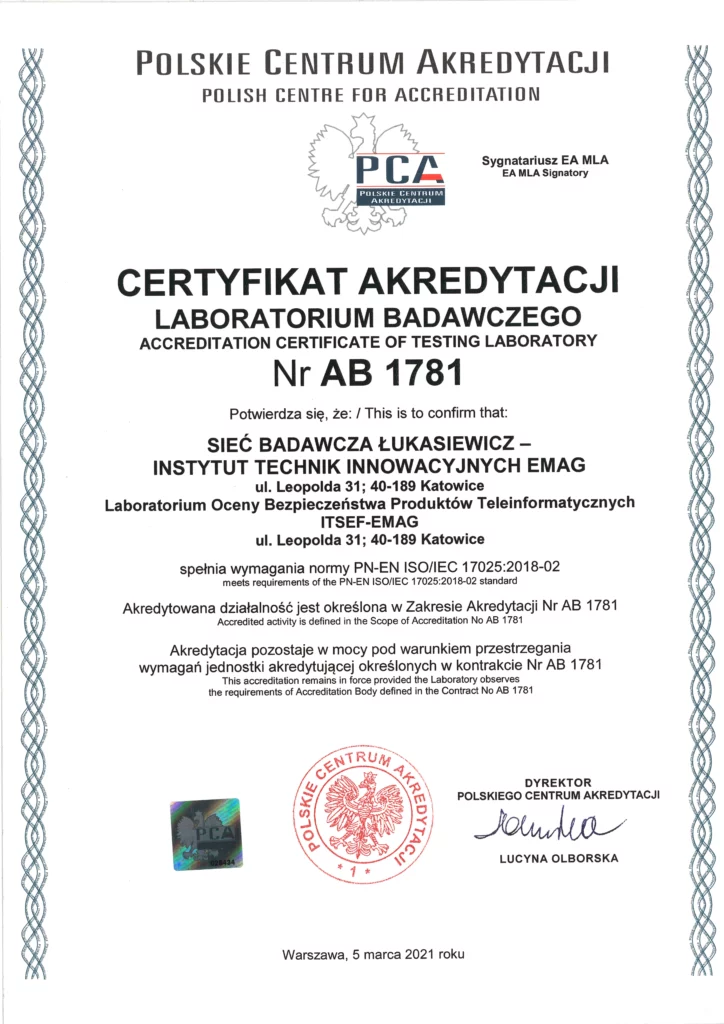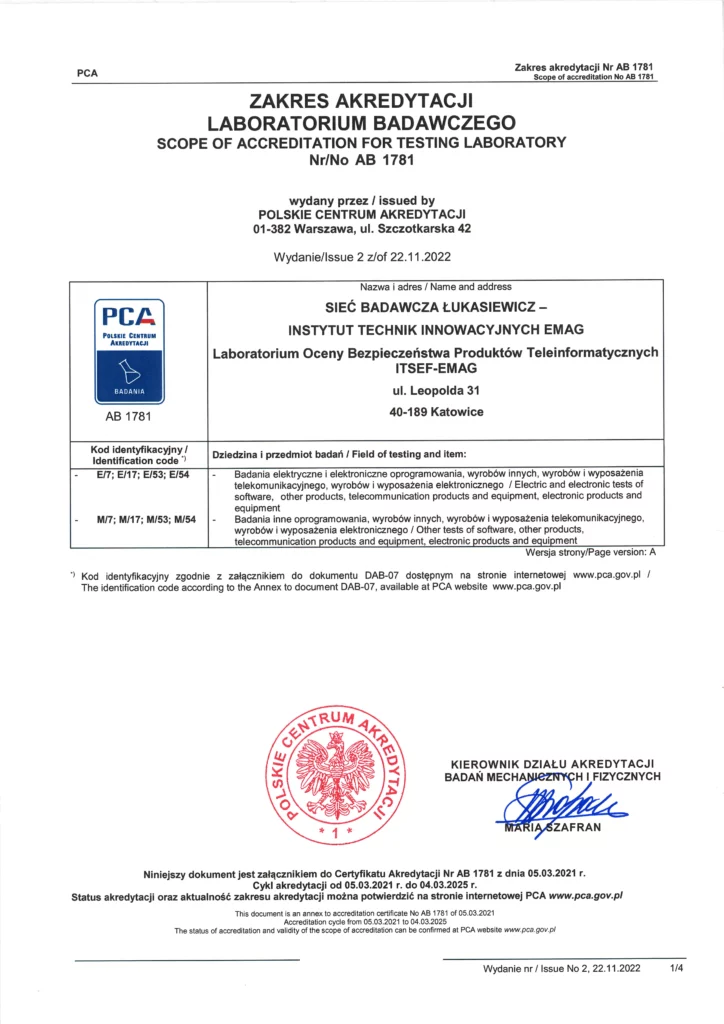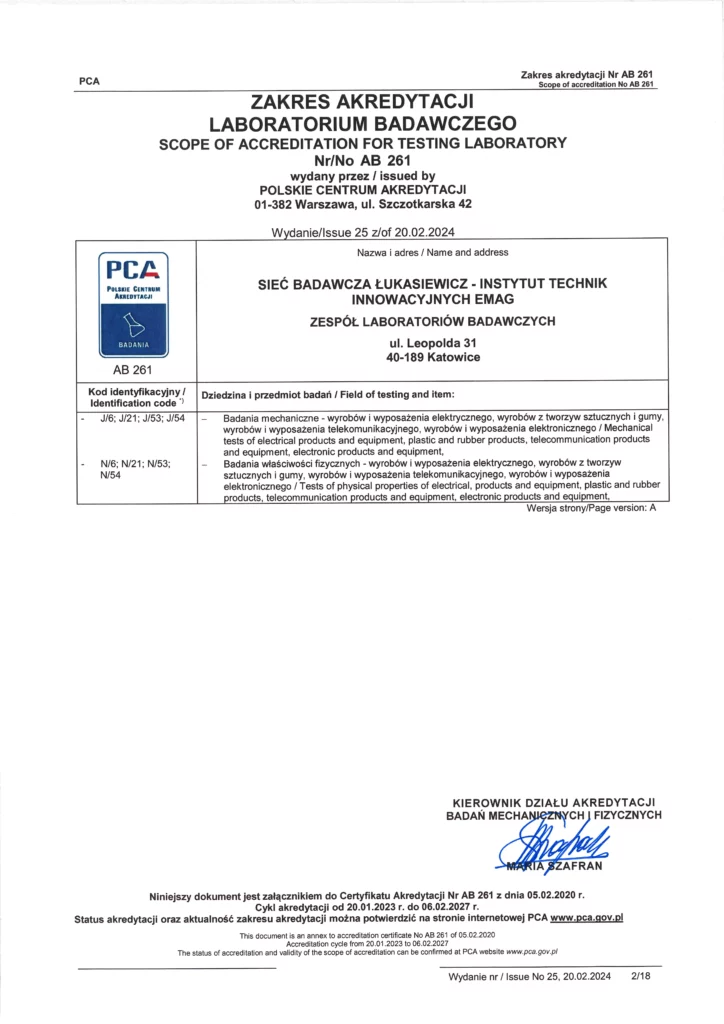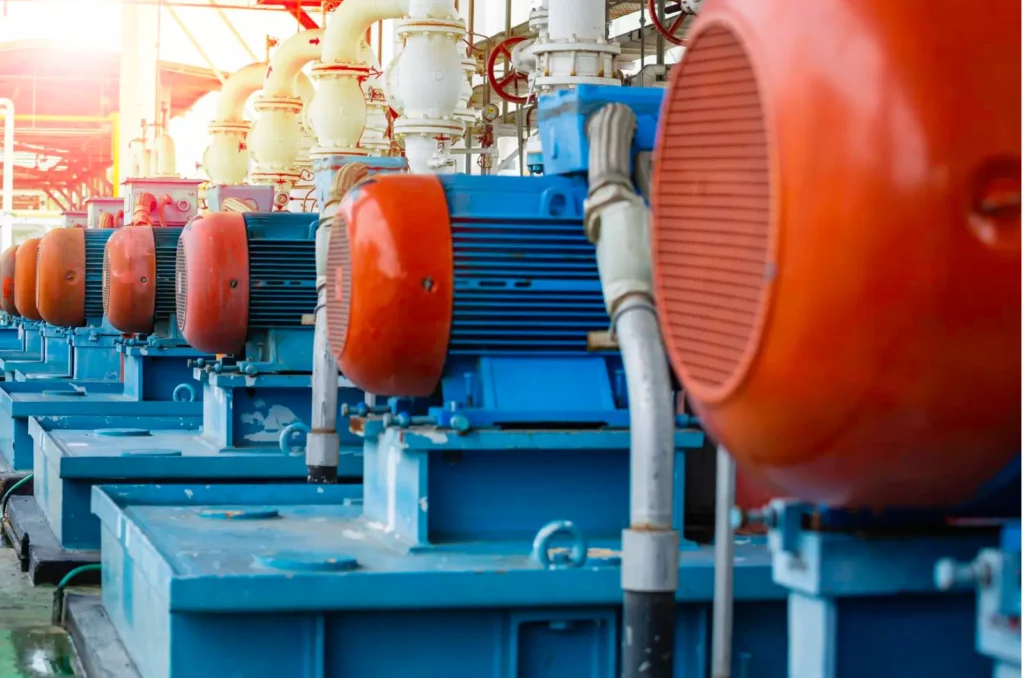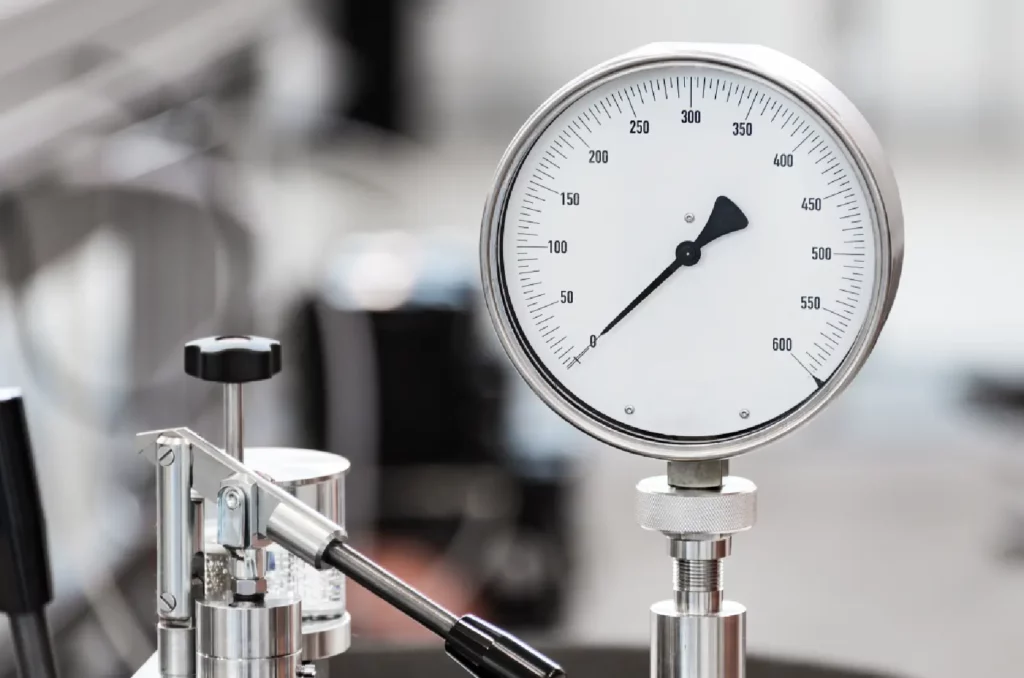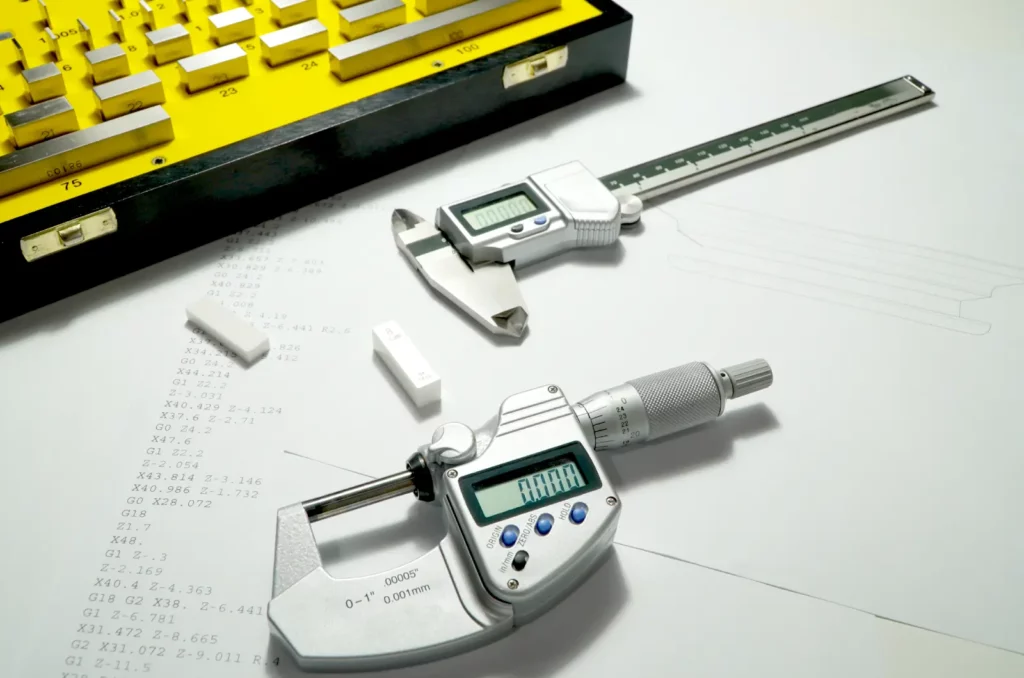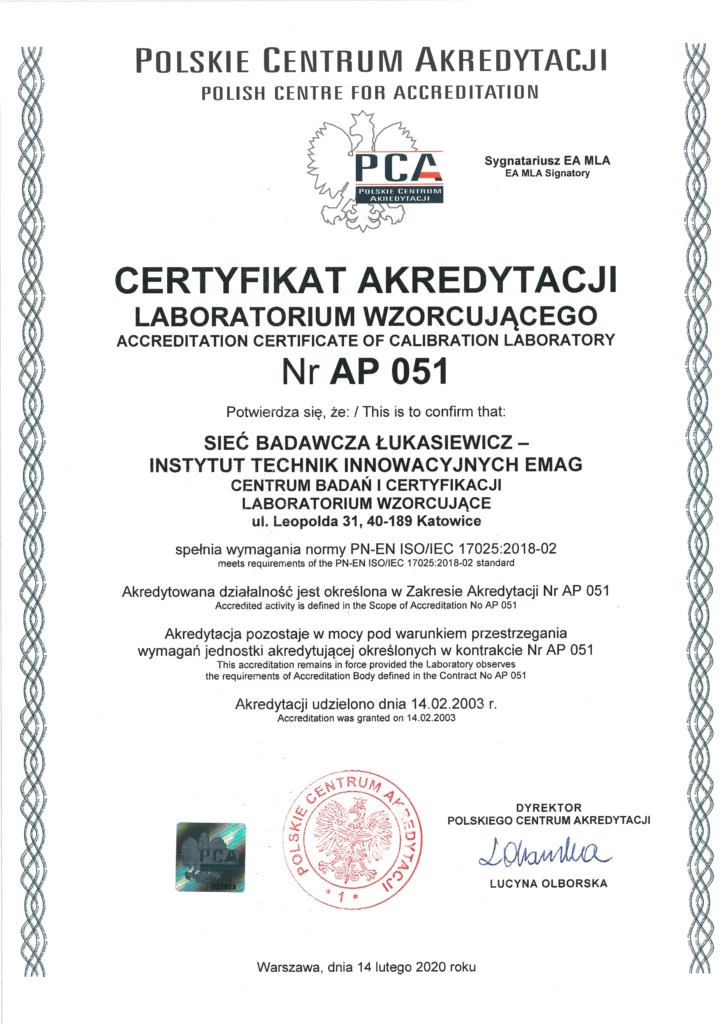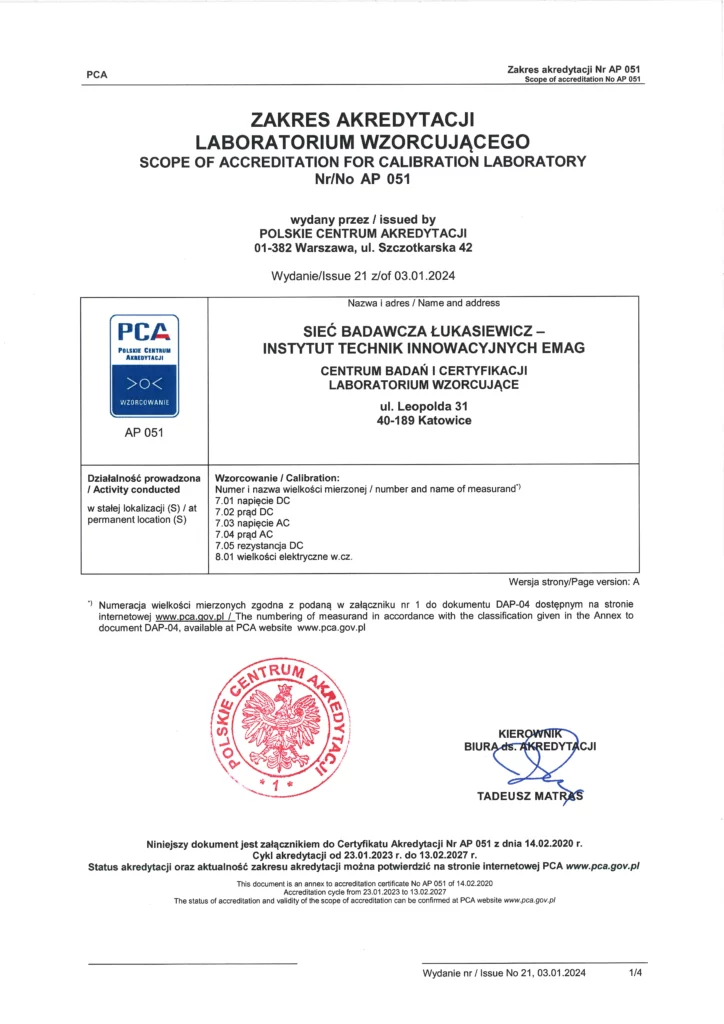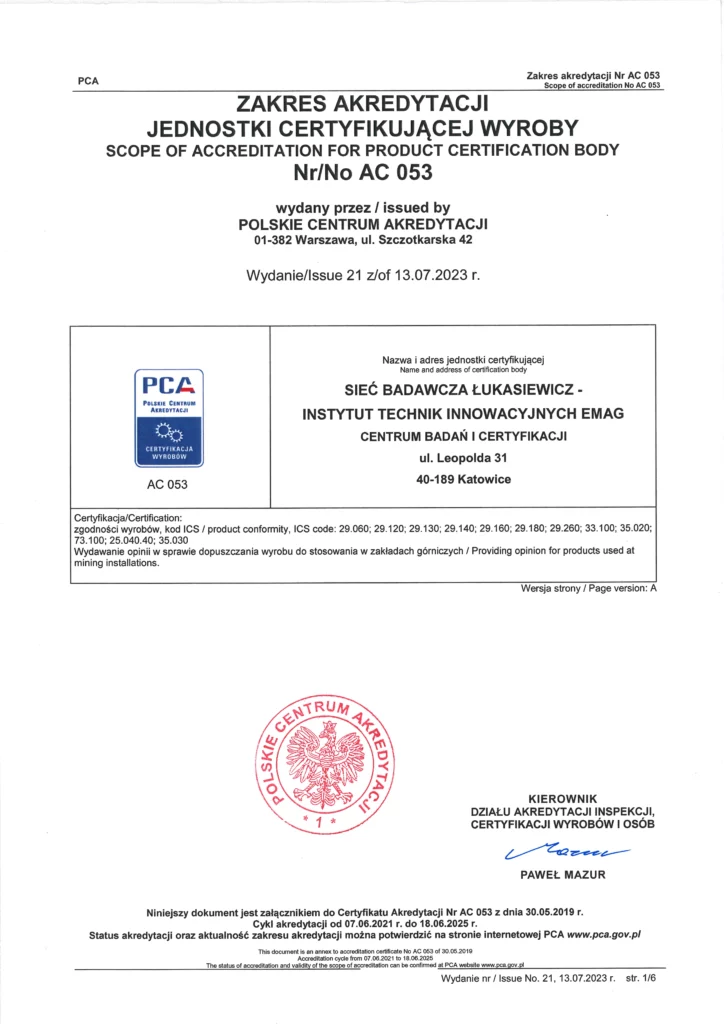- ITSEF Laboratory (IT Security Evaluation Facility)
- Radio Equipment Laboratory
- Electromagnetic Compatibility Laboratory
- Cable Testing and Environmental Testing Laboratory.
- Electrical Machines and Equipment Testing Laboratory.
- Gas Measuring Devices Laboratory
- Calibration Laboratory
- Accredited certification body.
Laboratory
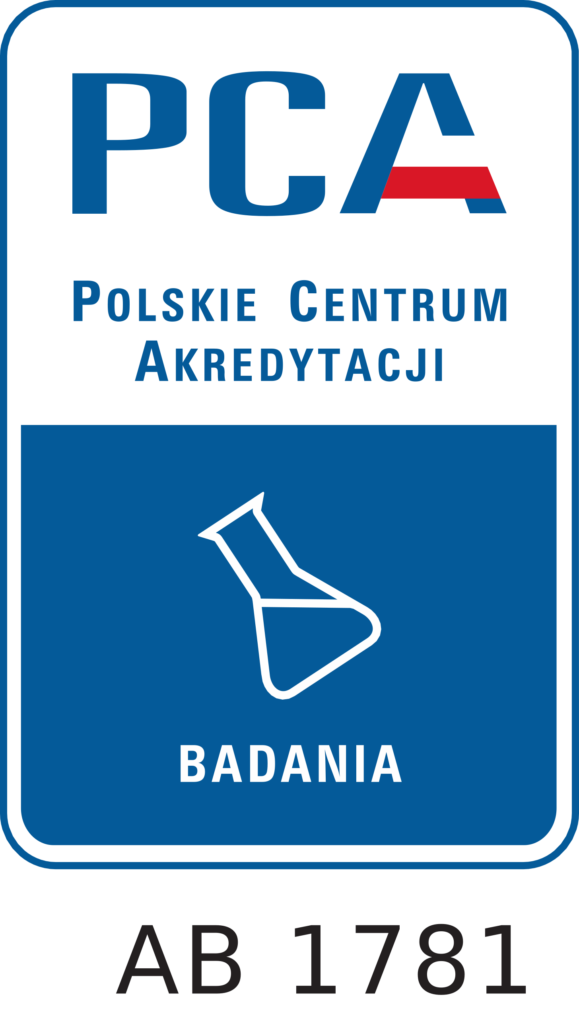
ITSEF Laboratory (IT Security Evaluation Facility)
The ITSEF Laboratory conducts security evaluations of products in areas such as information technology, energy and smart power grids, smart metering, industrial automation and control systems, automotive, Internet of Things (IoT), Industrial Internet of Things (IIoT), telecommunications networks, public administration, and critical infrastructure components.
The goal of the assessments is to verify the effectiveness of the security measures applied in the product and to evaluate the product’s documentation according to the evaluation criteria defined in the Common Criteria standard.
The evaluations are carried out with the level of detail and rigor specified for the required Evaluation Assurance Level (EAL), for which a certificate is issued. The evaluation is conducted at assurance levels ranging from EAL 1 to EAL 4.
The higher the specified EAL level, the more rigorous the evaluation process, the more thorough the vulnerability analysis, and the higher the attack potential used in the penetration tests.
The evaluations include security assessment, design documentation and security architecture review, product manufacturing environment audit, security function testing, vulnerability analysis, and penetration testing.
Depending on the product and the chosen EAL level, the evaluations last from 2 to 8 months.
Products subject to evaluation in the following areas:
- Industrial infrastructure – components of industrial automation and control systems: programmable controllers, SCADA systems, HMI, RTU, smart metering sensors, IIoT components
- Network infrastructure – switches, firewalls, gateways, cybersecurity probes, data diodes, wireless network components
- IT infrastructure: security incident detection software, antivirus systems, operating systems, and databases
- Identification and authentication – HSM solutions, devices and software for electronic signatures, smart cards, and processors
- Certification costs comparable to other European laboratories
- The entire certification process conducted within the Polish certification program based on documentation in Polish
- Access to consultations and training led by Polish specialists
- Security assessment performed by an independent and impartial third party in a laboratory accredited by PCA
- Product security certificate issued within the Polish certification program by a Certification Body operated by the Research and Academic Computer Network (NASK – PIB)
- Internationally recognized certificate in the CCRA and SOG-IS agreements
- Publication of certification information on the international Common Criteria portal. (https://www.commoncriteriaportal.org/products/)
- Publication of certification information on the Certification Body’s portal. (https://www.nask.pl/pl/dzialalnosc/certyfikacja/wykaz-certyfikatow/3766,Wykaz-certyfikatow.html)
- Customer support in preparing the product for evaluation and consultations on developing the Security Target and product documentation
- Introductory training on the Common Criteria standard
- Implementing best practices in the design of secure IT products.
- Increased product competitiveness in domestic and international markets
- Increased customer trust in certified products
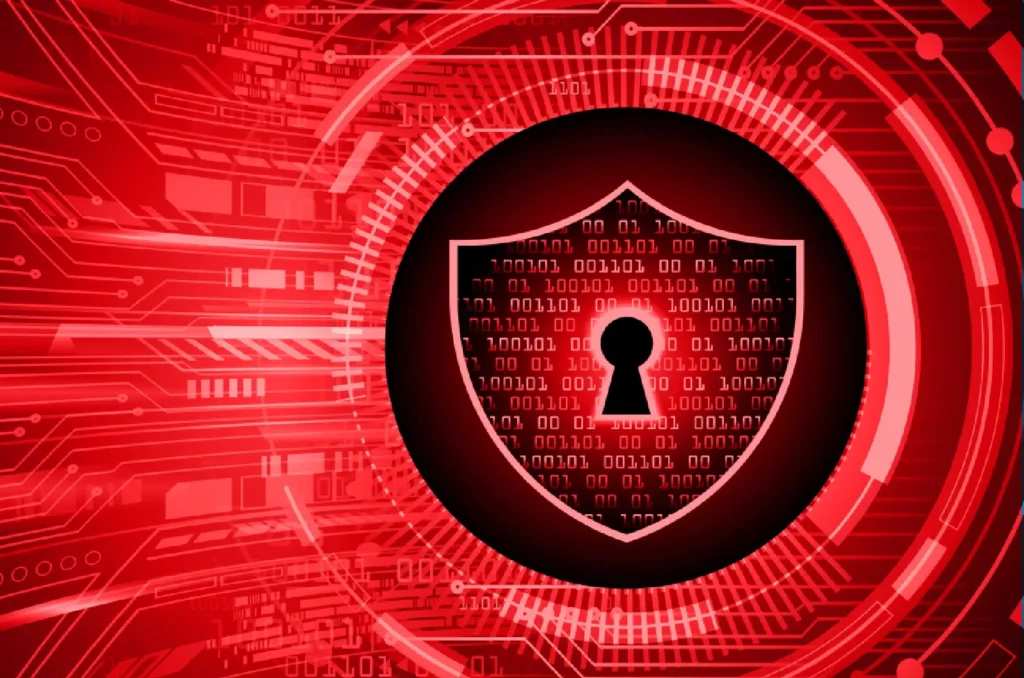
Service recipients
The laboratory’s offer is aimed at manufacturers of IT products in the form of software, hardware components, and hardware-software solutions that incorporate any IT security measures designed to protect the data processed and stored in these products.
Accreditation by the Polish Centre for Accreditation
No. AB 1781
Laboratory
phone: +48 32 2007 522, +48 32 2007 512
email: lab_zlr@emag.lukasiewicz.gov.pl
The laboratory addresses the market demand for testing industrial devices integrated with both wired and wireless telecommunications systems.
It has the capability to measure radio signals across a wide frequency range, test a variety of radio interfaces, including measurements of transmitter and antenna radiation characteristics, and conduct functional and electromagnetic compatibility tests in a fully simulated digital radiocommunication path for various telecommunications standards.
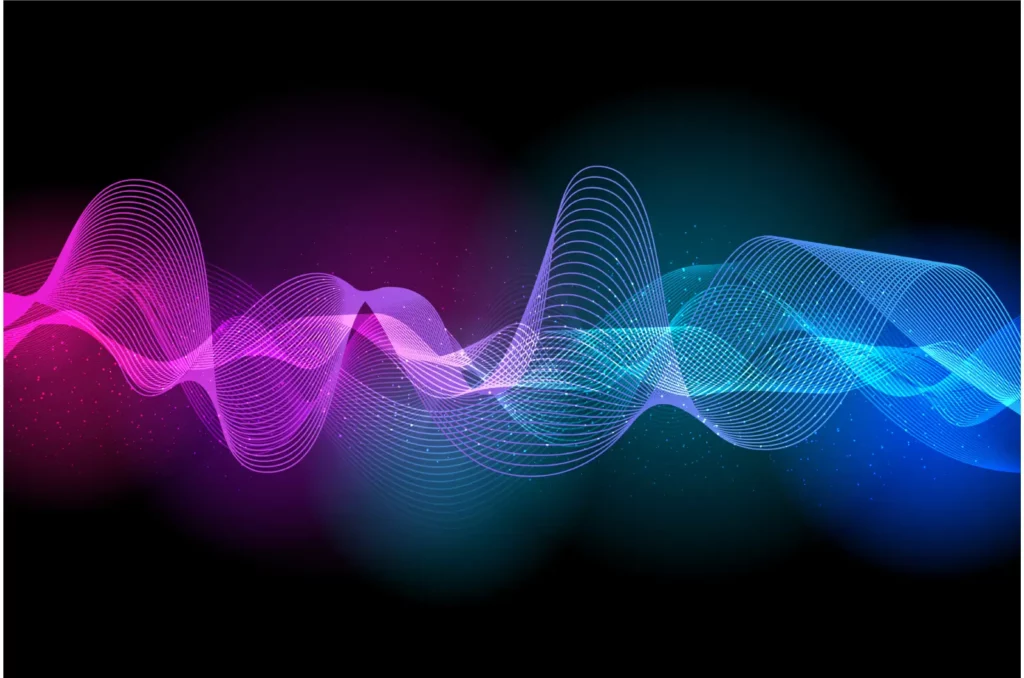
Service recipients
The laboratory’s offer is aimed at manufacturers of IT products in the form of software, hardware components, and hardware-software solutions that incorporate any IT security measures designed to protect the data processed and stored in these products.
Laboratory
Research activities are conducted in two locations. The first is located at the main headquarters of the institute in Katowice and has two semi-anechoic chambers with a measurement distance of 3 meters. These chambers allow for both electromagnetic interference measurements and testing the immunity of devices to radio frequency electromagnetic fields.
Measurements are performed in the frequency range from 100 kHz to 18 GHz, and immunity testing in the frequency range from 80 MHz to 6 GHz, with the possibility of reaching field strengths of several hundred V/m, which is unique on a national scale.
The second location is in Białystok, at the Białystok Science and Technology Park. The facility is equipped with a semi-anechoic chamber that allows for measurements and testing within the same frequency ranges but with a larger measurement distance of 5 meters. This enables the measurement of electromagnetic interference from larger devices. These chambers allow for testing and measuring devices weighing up to 1.5 tons.
Additionally, the laboratory in Białystok is equipped with a power supply simulator that enables powering the tested objects with direct or alternating current of any waveform, up to 400V and 32A.
Both laboratories are also equipped with a variety of measurement and testing equipment, enabling the performance of emission and immunity tests according to a wide range of CISPR and CENELEC standards, including several standards from the IEC 61000-4-x series, which describe issues related to the propagation of various types of disturbances in cable networks.
Both locations conduct tests on devices with various types of signal, communication, and power lines, for both AC and DC currents of up to several dozen amperes. The laboratories are continuously expanding their sets of artificial networks and coupling devices to handle increasingly higher values of current, voltage, and frequency bandwidths of telecommunications signals, as well as new types required by the latest editions of relevant standards and testing methods.
In addition, the laboratories can provide high-power energy reception thanks to resistive load sets. When it is not possible to perform electromagnetic interference measurements in laboratory conditions, for example, due to the inability to divide the system into smaller functional modules, the laboratories can also perform measurements of the entire system at the installation site (so-called “in situ” measurements).

Service recipients
The recipients of the services are manufacturers of various electrical and electronic devices, as well as others, such as radio systems, telecommunications devices, industrial equipment, medical equipment, scientific instruments, multimedia, computer hardware, and consumer electronics.
Accreditation by the Polish Centre for Accreditation
No. AB 261
Laboratory
Contact
phone: +48 32 2007 516, +48 32 2007 512
email: lab_zlk@emag.lukasiewicz.gov.pl
The key areas of its activity are:
- Testing of low and medium voltage cables and wires.
- Environmental testing.
- IP protection rating testing.
Testing of low and medium voltage cables and wires.
- Electrical (e.g., insulation resistance measurements, insulation strength tests, or capacitance measurements)
- Mechanical (e.g., testing tensile strength and elongation at break, tests for winding and impact resistance, or bending resistance)
- Physical properties (e.g., dimension checks or heating tests).
- Fire resistance (e.g., testing oxygen index or flame spread).
Environmental testing:
- Cold and heat,
- Constant and cyclic humidity,
- Temperature changes (including thermal shock),
- Low pressure,
- Vibration and mechanical shock,
- Spring hammer impacts,
- Salt mist (non-accredited).
IP protection rating testing:
- Testing protection against solid foreign objects and access to hazardous parts from IP3X to IP6X,
- Testing protection against water ingress from IPX1 to IPX9k.
A detailed description of the testing methods can be found in the PCA accreditation scope No. AB 261.
The laboratory is equipped with, among others:
- Angelantoni ACS WZH 30 climate chamber with a capacity of 30 m³, featuring a temperature range from -70°C to 80°C and humidity up to 95% RH.
- Angelantoni ANYVIB 1200 climate chamber with a capacity of 1 m³, offering a temperature range from -70°C to 180°C and humidity up to 98% RH. It is compatible with a vertical axis vibration system.
- Climats TAH 1000 pressure (vacuum) climate chamber with a capacity of 1 m³, featuring a temperature range from -70°C to 100°C, humidity up to 95% RH, and pressure adjustable from atmospheric level to 10 mBar.
- Climats SCAL 1000 shock climate chamber with a capacity of 1 m³, equipped with a hot chamber that maintains temperatures from 60°C to 200°C and a cold chamber with a range from -85°C to 180°C (which also functions as a stand-alone rapid climate chamber). It includes an elevator for quick transfer between chambers.
- TIRA TV59349 vibration system with a nominal force of 99,000 N for mechanical shocks and 49,500 N for vibrations. It is equipped with a slip table and allows vibration and mechanical shock testing in three perpendicular axes.
- King Design ST-8010 gravitational shock system that enables vertical axis mechanical shocks with acceleration up to 15,000 m/s² (and up to 100,000 m/s² for small objects with the appropriate attachment
- Angelantoni DCTC 1200 salt spray chamber with a usable capacity of 955 liters, designed for corrosion testing in salt spray (NaCl) environments at temperatures from ambient conditions to 55°C, with constant humidity up to 98% RH.
- The Angelantoni SD 1000 dust chamber with a capacity of 1 m³, along with the accompanying test station and probe set, enables testing of protection levels from IP3X to IPX9K.
The water testing station allows for protection level testing from IPX1 to IPX9K. - Milli-To 3 high-precision ohmmeter for measuring resistance from 1 mΩ to 100 TΩ (with a measurement voltage up to 500 V DC).
- Voltage devices enabling insulation tests at voltages up to 75 kV AC 50 Hz and 6 kV DC.
Precision temperature meters and recorders with measurement ranges from -70°C to 250°C.
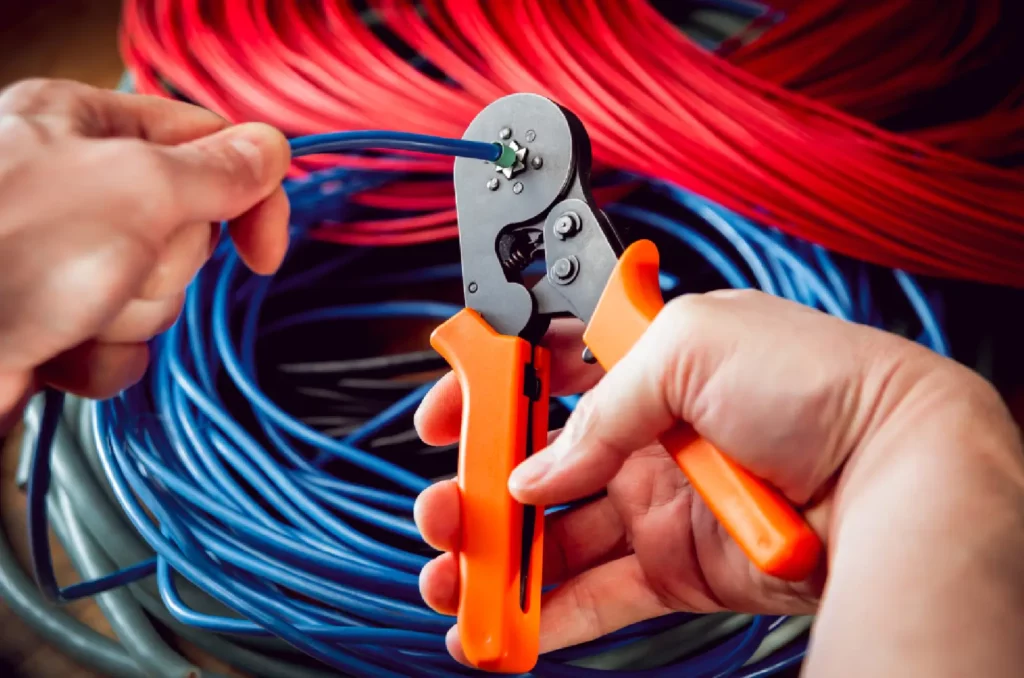
Service recipients
Accreditation by the Polish Centre for Accreditation
No. AB 261
Laboratory
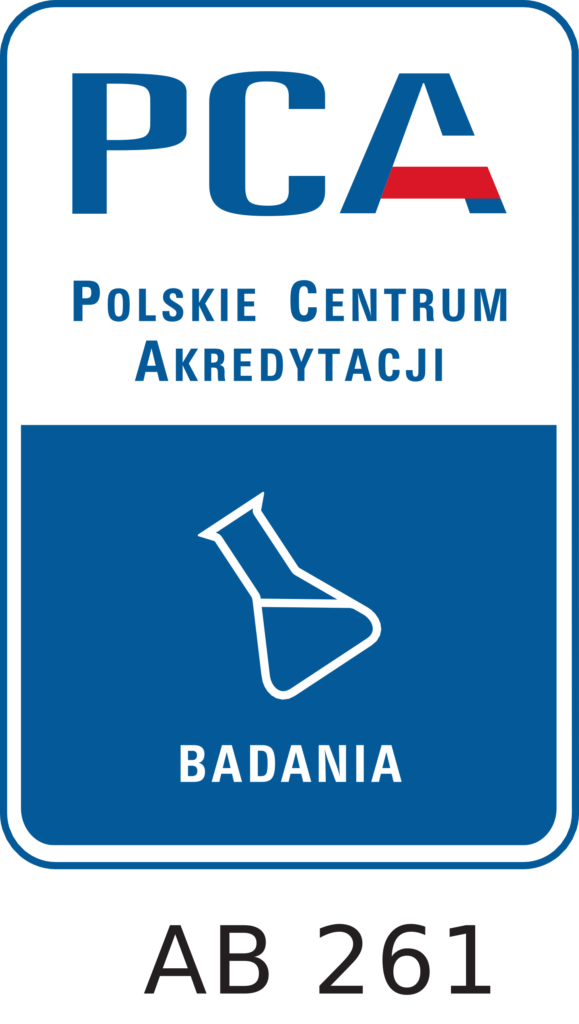
Electrical Machines and Equipment Testing Laboratory.
Contact
phone: +48 32 2007 516, +48 32 2007 512
email: lab_zlk@emag.lukasiewicz.gov.pl
The key areas of the laboratory’s activities are:
- Safety testing of electrical devices (LVD), including testing in accordance with the PN‑EN IEC 62368 standard.
- Testing of mining equipment.
Safety testing of electrical devices:
In this area, the laboratory conducts key tests from the perspective of user safety, aimed at confirming product compliance with Directive 2014/35/EU of the European Parliament and Council (the LVD directive) and the Regulation of the Minister of Development, Journal of Laws 2016, item 806 (on the requirements for electrical equipment).
Testing of mining equipment.
- insulation resistance measurements,
- electrical insulation strength tests,
- functional tests,
- heating tests.
The most important tests offered include:
- insulation resistance measurements,
- electrical insulation strength tests,
- leakage current measurements,
- temperature rise tests,
- surge immunity tests,
- accessibility checks for live parts,
- verification of the protective grounding (PE) circuit,
- power and current consumption measurements,
- high-current load tests,
A detailed description of the testing methods can be found in the PCA accreditation scope No. AB 261.
Laboratory

Gas Measuring Devices Laboratory
Contact
phone: +48 32 2007 526, +48 32 2007 512 email: lab_zle@emag.lukasiewicz.gov.pl
The Gas Detection Equipment Testing Laboratory can be divided into two sections. The first focuses on testing devices for detecting hazardous gases, while the second deals with the analysis of solid fuels.
The first section is an accredited laboratory under the PN-EN 17025 standard, holding PCA accreditation certificate No. AB 261. It specializes in testing carbon monoxide detectors (PN-EN 50291-1), toxic gas sensors (PN-EN 45544-1), and explosion-proof devices (PN-EN 60079-11).
Additionally, the laboratory conducts tests on sensors outside the scope of accreditation, including combustible/explosive and toxic gas detectors.
The Gas Detection Laboratory is equipped with specialized equipment that allows for the precise selection of gas mixtures suitable for the type of device being tested. It also includes climate chambers that enable the adjustment of gas parameters (such as setting specific gas temperature and humidity), as well as meters for measuring electrical parameters, sound intensity, and other necessary apparatus for conducting both prototype and final product testing of gas detection devices.
The second part of the laboratory specializes in solid fuel analysis and is equipped with advanced chemical analyzers and essential tools for analyzing coal, pellets, and sludge. These analyses provide detailed measurements of:
- transient and total moisture content,
- ash content,
- heat of combustion and calorific value,
- volatile matter content,
- total sulfur content,
- total carbon content,
- total hydrogen content,
- Reduction Index (RI)
- sieve analysis,
The laboratory also participates in innovative projects, collaborating in the development of alternative solid fuels.
Laboratory
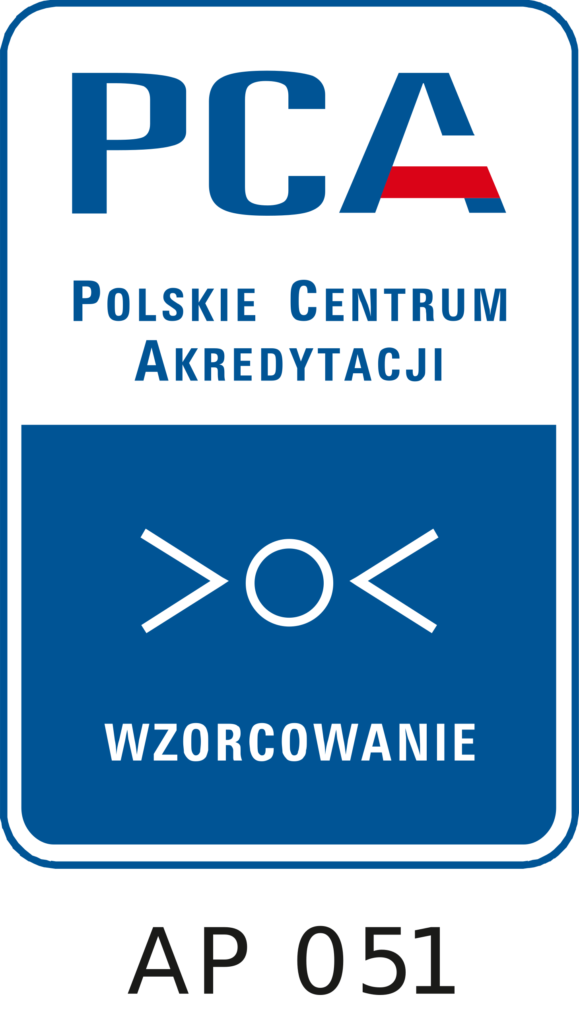
Calibration Laboratory
Contact
phone: +48 32 2007 526, +48 32 2007 512
email: lab_zle@emag.lukasiewicz.gov.pl
The laboratory is equipped with specialized laboratory equipment, enabling both the generation of reference signals and the measurement of calibrated signals.
In the field of low-frequency devices, the laboratory performs calibrations of the following instruments, among others:
- analog voltmeters, ammeters, and ohmmeters
- digital voltmeters, ammeters, and ohmmeters
- analog and digital multimeters
- digital insulation resistance meters
- fixed and adjustable resistors
- ESD (electrostatic discharge) meters
- digital recorders and transducers
In the field of high-frequency (RF) devices, the laboratory performs calibrations of the following instruments, among others:
- ESD generators (according to standards PN-EN 61000-4-2 and ISO 10605)
- EFT/BURST generators for fast electrical transients (according to standard PN-EN 61000-4-4)
- complex waveform generators SURGE (according to the standard PN-EN 61000-4-5)
- Voltage dip, short interruption, and voltage variation generators, compliant with the PN-EN 61000-4-11 standard.
- Coupling-decoupling networks (CDN), compliant with the PN-EN 61000-4-6 and PN-EN 55016-1-2 standards.
- Artificial networks (LISN), compliant with the PN-EN 55016-1-2 standard.
Passive components (attenuators, matching circuits, adapters, RF cables).
The laboratory also performs calibrations of devices outside the scope of PCA accreditation, such as:
- climatic and thermostatic chambers
- Temperature sensors
- Pressure transducers
The results of the work conducted in the Laboratory are calibration certificates containing test results along with measurement uncertainty (determined in accordance with the EA-4/02 guide).
We also offer a service for confirming the compliance of the measurement results of the calibrated device (in accordance with the ILAC-G8 document), within the calibrated range, based on the technical data (permissible indication/measurement error) provided in the user manual, standard, or other documentation.
Laboratory

Accredited certification body.
Contact
phone: +48 32 2007 521, +48 32 2007 512
email: jcw@emag.lukasiewicz.gov.pl
The Certification Body’s scope of accreditation includes the following products:
- Electric cables and wires, particularly those requiring approval for use in underground mining facilities in Poland;
- Lamps and their equipment;
- Telecommunication products, audio and video equipment, electrical energy receivers (EMC scope);
- Devices for measurement and control in production processes, and IT security devices – new addition.
The certification body is also authorized to issue opinions on products approved for use in mining facilities, specifically electrical machinery and equipment, as well as switchgear operating at voltages above 1 kV AC or above 1.5 kV DC.
Certificates are issued on a voluntary basis, when the client or product recipient requires confirmation of compliance for a manufactured or imported product. The evaluation of the product can be based on test results from Łukasiewicz – EMAG’s own laboratories or other competent external laboratories.
Download:
- information brochure
- Certification application form
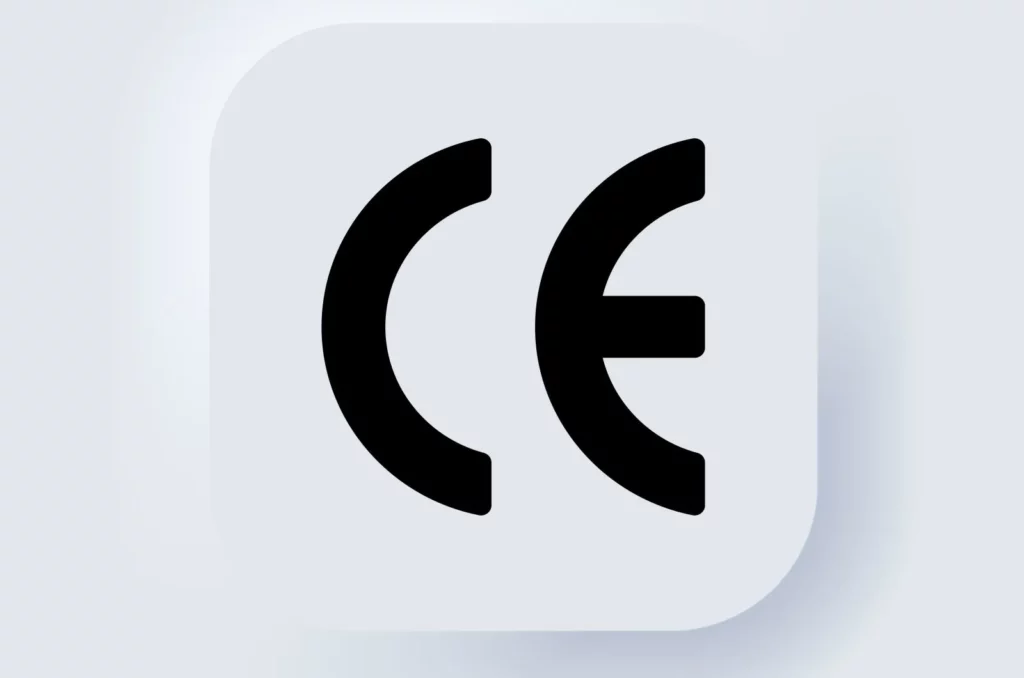
Service recipients
The recipients of the unit’s services are companies and institutions that require third-party assessment for their products being placed on the market within the EU, as well as manufacturers or distributors of products that require WUG approval for use in underground mining facilities.
Accreditation of the Polish Centre for Accreditation
No. AC 053
Contact
Secretariat of the Research and Certification Centre
Tel.: 32-2007-512
email: cbc@emag.lukasiewicz.gov.pl
email: emag@emag.lukasiewicz.gov.pl
